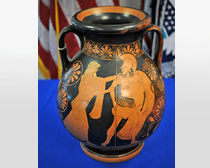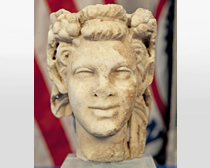The Foreign Cultural Exchange Jurisdictional Immunity Clarification Act (FCEJICA or S.2212) is a good bill worthy of passage. Its adoption by the U.S. Senate would support international cultural exchange by strengthening our country’s longstanding commitment to promote foreign lending of objects to American museums. The legislation reaffirms the statutory immunity afforded to imported artwork for the last 35 years, but which has been weakened by the courts.
Foreign lending benefits the American public and provides an important mechanism to supply our country’s museums with documented archaeological artifacts. In an otherwise sharply divided Congress, it is noteworthy that the bill was sponsored and passed in the House (H.R. 4086) and now sponsored in the Senate by members from both sides of the aisle.
The proposed bill clarifies the spirit of a federal law in force for over three decades, but weakened in the last few years. Congress in 1965 passed IFSA (formally known as the Immunity from Seizure Under Judicial Process of Cultural Objects Imported for Temporary Exhibition or Display). Lawmakers passed it because they wanted to promote the importation of art. They wanted to let foreign art lenders know with certainty that their cultural works would not become entangled in litigation once on American soil.
IFSA’s statutory language specifically protects against potential judicial seizure of imported objects of cultural significance intended for temporary, nonprofit exhibition. The law prevents a civil litigant from seizing temporarily imported fine art to satisfy a judgment in a lawsuit, for example.
The immunity given by IFSA is not automatic. Nonprofit museums must apply for this immunity when seeking to import foreign cultural objects for temporary exhibit. Any immunity that may be granted by the President of the United States, through his designee, is specific to the artwork; the immunity does not apply to the museum.
To acquire this immunity, a museum must submit an application to the U.S. Department of State. The application includes a description of the item covered, its provenance, its exhibition location, a description of the object’s cultural significance, and a description of why the temporary exhibition is in the national interest. With regard to provenance, the State Department asks an applicant to certify that it has “undertaken professional inquiry … into the provenance” and that it either knows, does not know, or does not have reason to know “of any circumstances … that would indicate the potential for competing claims of ownership ….” If there is reason to know of any potential dispute concerning the object, the applicant must disclose it. The President then authorizes the State Department “(1) to determine that any work of art or other object to be imported into the United States … is of cultural significance, (2) to determine that the temporary exhibition or display of any such work of art or other object in the United States is in the national interest, and (3) to cause public notices of the determinations referred to above to be published in the Federal Register.”
Since IFSA was passed, many objects from abroad have been immunized from potential seizure. Several requests already have been granted so far this year. For example, African objects loaned to the Smithsonian Institution's National Museum of African Arts were granted immunity. They will be in a special exhibition called “African Cosmos: Stellar Arts.” The “Decree Stele” from the National Archaeological Museum in Athens, Greece is another object granted immunity. It will be on loan at the Getty Museum in California through 2015. Meanwhile, the Jewish Museum in New York obtained immunity for imported pieces that are included in its current exhibition titled “
EdouardVuillard: A Painter and His Muses, 1890-1940.” And the Metropolitan Museum of Art's show titled
“The Dawn of Egyptian Art” features pieces immunized by IFSA in February.
Loans promote cultural exchange, which is of vital public benefit. Cultural exchange enlightens our minds to other civilizations; inspires school children to become archaeologists, historians, and art lovers; causes us to care about our history and heritage; and promotes understanding between citizens of different nations, languages, religions, and races. The FCEJICA's enactment would continue to promote international cultural exchange by shielding foreign lenders and their art from unforeseen lawsuits, including those that could be frivolous.
Because cultural exchange through foreign lending is a benefit to all Americans, it is important to eliminate reservations that foreign lenders may have when choosing to exhibit cultural objects in the United States. Foreign lenders must be encouraged to lend art and artifacts to American museums. Complete immunity can provide an incentive. Complete immunity shields both the object loaned and the lender from civil lawsuits in a way that partial immunity cannot. Indeed, partial immunity is no immunity at all.
Partial immunity is arguably all the State Department can give under IFSA if one follows the reasoning of the federal district court’s decision in Malewicz v. City of Amsterdam (2005). That case applied the Foreign Sovereign Immunities Act (FSIA) and undermined IFSA’s immunity. The FSIA is a law that generally protects foreign states from lawsuits. The law was interpreted by the Malewicz court to extend jurisdiction over foreign governments when their artwork was displayed in the U.S. even when immunity had been given to the art under IFSA. That is because the lending of art objects was deemed a “commercial activity.” The FSIA says that “[a] foreign state shall not be immune from the jurisdiction of courts … in which rights in property taken in violation of international law are in issue and that property … is present in the United States in connection with a commercial activity carried on in the United States by the foreign state … [or an] instrumentality of the foreign state ….” (italics added).
In Malewicz, the heirs of Kazimir Malevich sued Amsterdam in federal court in Washington, DC to either recover artworks that the city’s Stedelijk Museum loaned to American museums or to acquire $150 million in damages. The heirs claimed that the foreign museum unlawfully obtained the paintings. Amsterdam, meanwhile, argued that IFSA protected it from a lawsuit. The federal court ruled that Amsterdam had engaged in “commercial activity” under the FSIA by loaning the art to the American institutions. While IFSA may protect the actual artwork from seizure, the FSIA did not protect Amsterdam from related damages, said the court.
Congress introduced S. 2212 to restore meaning to IFSA’s immunity, erasing any potential conflict between IFSA and the FSIA. The bill adds a new section to the FSIA that protects foreign nations and their entities from lawsuits related to loaned cultural objects, excepting Nazi looted art. This effort to strengthen IFSA is meant to assure foreign lenders that they will not be targets of civil litigation simply because they decide to have their art or artifacts exhibited in the U.S.
Securing foreign lending opportunities for American museums is a goal of IFSA and S.2212, and foreign lending serves to provide one solution to the problem of illegally trafficked antiquities. We know that undocumented and unscientifically excavated artifacts have ended up in museum collections. Italy, among other nations, has recovered a number of looted artifacts from prominent institutions across America in recent years. It worked out agreements whereby looted cultural objects were repatriated to the country. The Italians, in turn, agreed to supply long term loans to museums such as the Metropolitan Museum of Art in New York and the Museum of Fine Arts in Boston. Adoption of the FCEJICA would serve to strengthen these and similar lending arrangements.
The assurances supplied by S.2212 would give greater comfort to Italy, Turkey, Egypt, Peru, India and other archaeologically rich nations that are willing to supply authentic, untrafficked artifacts of the past to American museums. Additionally, the FCEJICA would give source nations protection from civil suits when archaeological or ethnological objects are loaned pursuant to Article II recommendations. Article II recommendations are often outlined when the United States adopts Memoranda of Understanding (MoU) with foreign countries under the Cultural Property Implementation Act (CPIA). The MoU implements import restrictions covering archaeological and ethnological material in jeopardy, and Article II may say, as in the case of the MoU with Guatemala: “The Government of the Republic of Guatemala shall use its best efforts to facilitate the exchange of its archaeological objects and materials under circumstances that do not jeopardize its cultural patrimony, such as temporary loans for exhibition purposes and scientific examination.” (italics added)
The State Department should always carefully examine IFSA requests that involve ancient artifacts or at-risk cultural objects. America naturally wants to do its best not to inadvertently immunize illegally dug-up archaeology or fine art stolen during a time of conflict. Avoiding a situation like the one in the Malewicz case is important. Statutory language might be adopted by the Senate that would require a reasonable assessment by the State Department of the provenance surrounding suspicious or at-risk objects—like those listed in CPIA bilateral agreements, those contained on ICOM Red Lists, or those that are suspected to have been stolen during times of war. As described above, the State Department already requires immunity applicants to list information about provenance and potential legal claims surrounding a cultural object so that it can review this information. Given that a review process already is in place, S.2212 might codify that the State Department shall conduct a reasonable inquiry into both the applicant's provenance investigation and the potential legal liabilities that may be connected with an object before an immunity request is approved.
There is always some language in a bill that can be tweaked, but reaching legislative perfection should not be an obstacle to passage of the FCEJICA in the U.S. Senate. Lenders need clear and iron-clad notice from America that their artworks or artifacts on loan--or that they themselves--will not be caught up in unexpected and expensive court proceedings simply because they choose to exhibit their artifacts or fine art to Americans.
CONTACT: www.culturalheritagelawyer.com 




